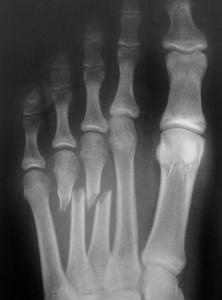Pelvic Fractures
The pelvis is formed of the three fused bones: ilium, ischium and pubis. The stability comes from strong ligamentous complexes. Blood supply is derived from the iliac arteries. If the pelvic ring is disrupted in two places and more the fracture should be considered unstable. Fractures are usually caused by high energy trauma and if internal bleeding occurs mortality is high. Immediate stabilisation with a pelvic binder and resuscitation are critical. Stable injuries can often be treated with protected weight-bearing.



Acetabular Fractures
The acetabulum is the pelvic part or socket of the hip joint. In younger patients the fractures are a result of high energy trauma; in the elderly it is more low energy such as falls. Treatment depends on the fracture pattern and location but surgery is typically indicated. If fractures are minimally displaced (less than 2 mm) protected weight-bearing can be considered.

Proximal Femur Fractures
The proximal femur can be divided into the head, neck, intertrochanteric and subtrochanteric region.


Femoral head fractures are rare. Larger fragments require surgery but the risk of avascular necrosis is up to 40%.
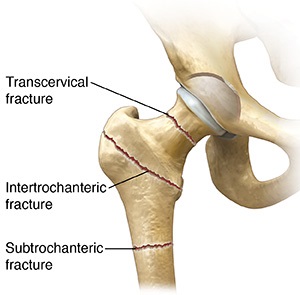
The femoral neck has a poor healing potential and even with surgery there is a risk of avascular necrosis of the femoral head. Nondisplaced fractures can be treated with screws and plates. Completely displaced fractures in the elderly benefit from joint replacement. Intertrochanteric and subtrochanteric fractures are commonly observed in the elderly. All fractures require surgery unless the risk of surgery is too high.
Femoral Shaft Fractures
These fractures occur more commonly in the younger population and are associated with high energy trauma. It is the largest and strongest bone in the body. Patients can lose up to 3000ml of blood into the thigh and advanced life support protocols should always be initiated. Early surgery is indicated either to control further sequela (external fixator as damage control) or definite treatment with an intramedullary nail.

Patella Fractures
These injuries can either occur via a direct blow or from strong eccentric contractions from the quadriceps muscle. Stable injuries can be treated with a brace and early weight-bearing. Displaced fractures require surgical fixation.

Tibial Plateau Fractures
These fractures involve the tibial part of the knee joint and the proximal tibia. Several types are described ranging from fractures of the lateral or medial plateau to both plateau fractures with severe comminution. Tears of the meniscus are common. Minimally displaced fractures can be treated with a brace and partial weight bearing but displaced fracture require surgical fixation.

Tibial Fractures
These are the most common long bone fractures. Due to its superficial location, open fractures are not uncommon. Compartment syndrome of is a serious complications and must be checked with every fracture. If these fractures are displaced less than 5 degrees in the coronal and less than 10 degrees in the sagittal plane, are less than 1 cm shortened and have no rotational component cast immobilisation can be considered. If these criteria are not fulfilled surgery is recommended.

Tibial Plafond Fractures
These fractures involve the roof of the ankle joint. Often they are caused by axial load such as a fall from a height or motor vehicle accidents. Nondisplaced fractures can be treated with cast immobilisation. Displaced fractures require surgical fixation. Due to swelling temporary fixation with a joint spanning fixator is required to avoid soft tissue complications. The complication rates for these injuries are high and range from wound problems (10%) to infection (up to 15%).
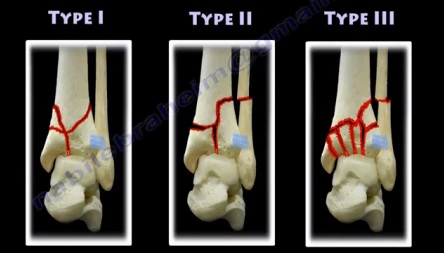
Ankle Fractures
The injury patterns for ankle fractures vary widely. They can range from isolated medial, lateral and posterior malleolus fractures to bimalleolar and open fractures. The injury pattern determines treatment. In general any displaced fracture and open fractures should be treated surgically. With any medial fracture, talar shift to the lateral aspect of the ankle joint or increased space between tibias and fibula and injury to the syndesmosis must be excluded.
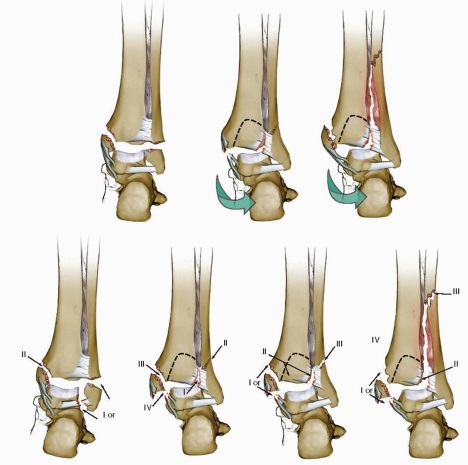
Talus Fractures
Forced dorsiflexion of the ankle with axial load can cause fractures of the talus. The most common location is the talar neck. Displaced fractures have a high risk of non-union and osteonecrosis. Non-displaced fractures can be treated in a cast but all displaced injuries require urgent reduction and internal fixation.
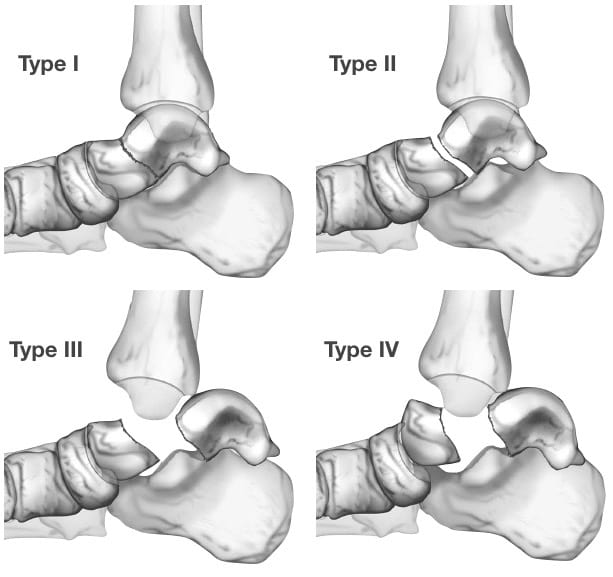
Calcaneus Fractures:
The most frequent fracture of the tarsal bones. Axial loading is the primary mechanism of injury. The principle treatment is to restore height, width, length and alignment to improve shoewear fit and gait. With intra-articular fractures restoration of the joint surfaces are critical. Is surgery is not needed cast immobilisation for 6 weeks with non-weight bearing is the current treatment recommendation.

Lisfrank Injury
The Lisfrank injury is a dislocation of the tarso-metatarsal joint. These injuries can range from mild sprains to severe dislocations. Awareness is critical. Swelling of the midfoot, tenderness, medial bruising are clinical signs. Weight-bearing radiographs should always be performed if patients can tolerate weight. MRI scans will demonstrate purely ligamentous injuries.
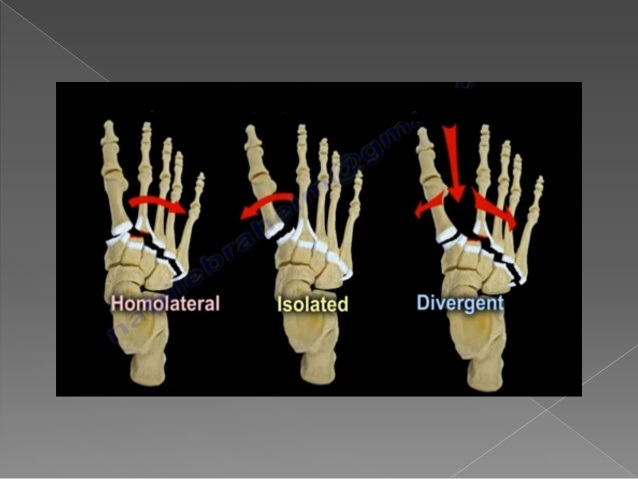
5th Metatarsal Fractures
This is a group of injuries that involve 3 zones. In zone 1the fracture is caused by a pull of the peroneus tendon. The classic Jones fracture is a zone 2 fracture, involves the joint between the 4th and 5th metatarsal. Zone 3 injuries of the proximal shaft are stress fractures and have a high risk of non-union. Zone 1 can be treated with protected weight-bearing. Zone 2 fractures in athletes benefit from surgery; in more sedentary non weight-bearing cast immobilisation is a good option. Zone 3 fractures often do not heal and require surgical fixation and often also bone-grafting.

Metatarsal Fractures
Mainly caused by direct crush injuries with associated soft tissue injury. The goal of treatment is to maintain the longitudinal and transverse arch of the foot. Non-displaced fractures can be treated in a walking boot with protected weight-bearing. Any displaced and open fractures should be treated with surgical fixation.
